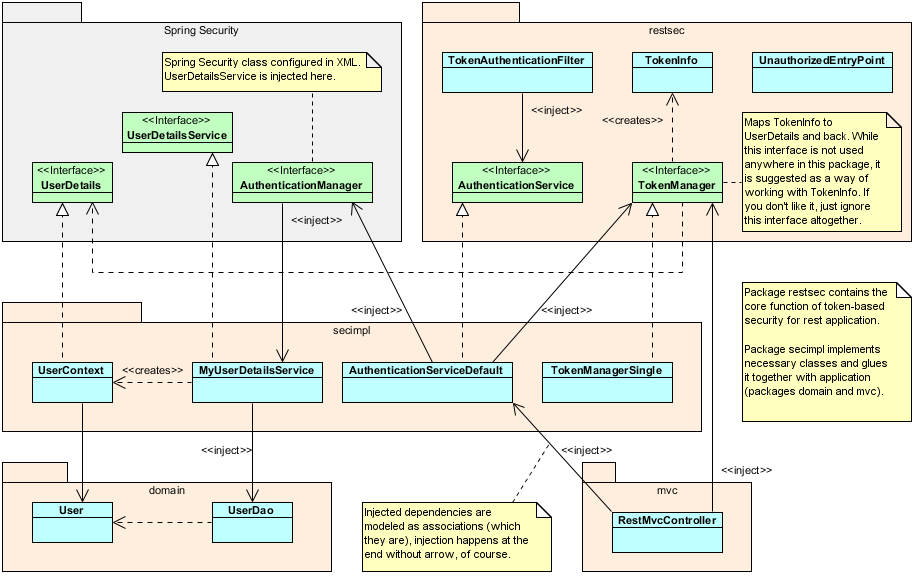Small test RESTful app with token based security. Its main reason is documentation for myself. :-) This demo features:
@RestControllers in separate MVC application context.- Main application context with
@Services and Spring Security (also parent for MVC context). - Following things are part of the security solution and must be configured:
- Security filter
TokenAuthenticationFiltertakes care of HTTP and usesAuthenticationServicethat takes care of the "security business". AuthenticationServicethat performs the main "security business". It uses Spring'sauthenticationManagerto authenticate users andTokenManagerimplementation that offers variability in policy how tokens should work.- Solution is separated into two packages. Package
restseccontains core if it and may work as a drop-in solution (adjust stdout debugs, etc). Packagesecimplis example howrestsecis glued with the actual application - here represented bydomainandmvcpackages.
- Security filter
- Gradle build with Spring IO Platform "bill of materials" (but Spring Boot repackage is disabled).
Demo does not feature any front-end JavaScript. Sorry. You have to use browser, preferably with something
like http://restclient.net/ - or even better with curl command.
Companion blog post: http://virgo47.wordpress.com/2014/07/27/restful-spring-security-with-authentication-token/
UML class diagram, yeah! That's what I missed most when I read Spring Security 3.1 book, actually. So hopefully you'll like it. If it does not make sense, let me know what's wrong with it. (BTW, check aforementioned blog post for sequence diagrams of login/logout/token check, etc.)
Demo is inspired by internal needs, took a lot of information from Google and StackOverflow - which lead me to: https://github.com/philipsorst/angular-rest-springsecurity/ That project has additional AngularJS and JPA, while I wanted to focus on Spring Security + MVC's @RestController only + practice Gradle a bit.
- If
context:component-scanis used in Spring configs, be sure to specify disjoint values forbase-package. You don't want your Controllers to be picked by main appcontext or the other way around. Separate JARs don't solve this because the resolution (initialization) is performed during runtime. - If login is repeated it is important to invalidate older tokens for the same user. Try http://localhost:8080/respsec/secure/mytokens with
X-Username: admin; X-Password: admin - it should display just a single token. Other policies can be chosen
implementing different
TokenManager, you can store more tokens for a user, let him manage those, etc. In such cases tokens may be bound to IP address depending on the needs.
- How to invalidate tokens after some time? How to refresh them seamlessly? Should client expect renewed token in any response?
- How to add more authorization mechanisms? Can we SSO to Windows Domain? Can we integrate something like Waffle?
Assuming appserver on 8080 and application context /respsec:
-
Start with login. Don't omit the last / or it will not be intercepted by Spring Security. POST must be used:
curl -i -X POST -H "X-Username: admin" -H "X-Password: admin" http://localhost:8080/respsec/Or to put the token into handy variable:
X_AUTH_TOKEN=`curl -i -X POST -H "X-Username: admin" -H "X-Password: admin" http://loc alhost:8080/respsec/ | grep "X-Auth-Token" | cut -d' ' -f2` && echo $X_AUTH_TOKEN -
Previous command returns X-Auth-Token, you have to use it in the following example (we can switch to GET now + we're adding new line after the output):
curl -i -w '\n' -H "X-Auth-Token: $X_AUTH_TOKEN" http://localhost:8080/respsec/secure/allusers -
Try to access the same without token or with an invalid one - should result in 401:
curl -i -w '\n' -H "X-Auth-Token: invalid" http://localhost:8080/respsec/secure/alluserscurl -i -w '\n' http://localhost:8080/respsec/secure/allusers -
After you try other API URLs, you can go for logout. It must be POST, GET will fall through the filter to the controller (if mapped):
curl -i -w '\n' -H "X-Auth-Token: $X_AUTH_TOKEN" http://localhost:8080/respsec/logout -
If you repeat the logout request, it will return 401, because the token is not valid anymore.
-
You can combine valid token and login, because login is internally performed after token validation. However, from the next request you have to use newly returned token.
-
If you combine login with invalid token, login will not be performed regardless of credentials provided.
-
To find out what Spring Security thinks you are, try debug request:
curl -i -w '\n' http://localhost:8080/respsec/test(anonymous)curl -i -w '\n' -H "X-Auth-Token: $X_AUTH_TOKEN" http://localhost:8080/respsec/test(authenticated user)
See test.sh for simple bash-based automatic test. Never wrote bash test before, but it works for me here. :-)
